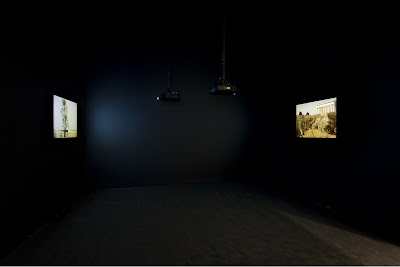Currently on view at the Museum of Modern Art, as part of the Projects series organized by Roxana Marcoci, Curator in the Department of Photography, is Projects 96: Haris Epaminonda. The Project Series is currently in its fortieth year at the Museum and has played a vital role in the contemporary art programs. Haris Epaminonda is based in Berlin, and this is her first exhibition at the Museum of Modern Art. For Projects 96 the artist has constructed an installation that occupies several small, connected rooms within the Contemporary Galleries on the 2nd floor. Within the context of the installation, the artist has utilized video projection, found objects, appropriated images and architectural intervention. White columns, plinths, and a niche in one of the walls, provide a quietly subtle transformation of the gallery and along with her choice of revealing and hiding objects, the viewer is temporarily transported into a place with historical resonance however an unclear reference to time.
Each object in the installation carries with it a strong sense of specificity. The walls and columns are white, so any hint of color whether in a photograph or sculpture, seems to vibrate with a certain kind of raw energy. At the basis of the exhibition is Chronicles (2010) a three-channel video projection The room where Chronicles is being shown is completely black, in contrast to the whitewash of the other rooms. The layout of the projection in space invites the viewer to move around, looking and comparing one screen to the next. The movement is slow and precise. Each short segment has been transferred from Super 8 film to video and features assorted content. One is a documentation of sorts of various ancient artifacts from different cultures shown in front of a color blocked space, or appropriated directly from the pages of a book. Another film shows views of the Acropolis while the third presents superimposed palm trees in a desert. The mirage is a metaphor, a visual notation referencing isolation of cultures and civilizations that have faded away long ago.
Epaminonda, born in Cyprus, 1980, earned her undergraduate degree along with her Master of Arts (2003) in England, the latter at the Royal College of Art. It was while living in London that she became fascinated with archives and cartographies. In 2007, she commenced upon a project called The Infinite Library along with German artist Daniel Gustav that includes books that are deconstructed, reassembled and reconfigured from their original format resulting in a new kind of content that doesn’t necessarily provide cohesive information or narrative. For her exhibition at MoMA, the video content is from her own archive and shot during research based excursions. Similar to The Infinite Library she approaches Chronicles as visual documentation and in eliminating naturalistic sequences assembles a catalogue of collage.
The only relevant information that the viewer has been given to attempt at establishing context before approaching the room containing the video are the found objects and appropriated images installed in the first two rooms of the gallery. As if given the chance to erect an imaginary architectural space the viewer collects visual building blocks in order to establish his/her own assumptions of time, place and physical presence. Epaminonda’s installation is quite formal in its approach. The most successful element in Projects 96 is her technique of revealing and obscuring information. Several objects have been placed on the gallery floor and behind white rectangular columns. In this action and choice, the artist removes a certain level of clarity, function and power from a particular item, repositioning the object and granting purpose solely through composition.
Projects 96: Haris Epaminonda will be on view at the Museum of Modern Art, New York until February 20th, 2012.
More soon
xo





